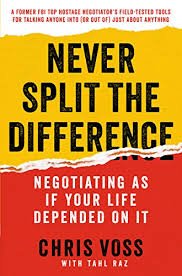I’ve always been fascinated with the art & science of negotiation. In some way, shape, or form, we negotiate almost every day. Within the last week or so, I’ve negotiated with my graduating senior on overcoming senioritis and taking his final AP exams seriously, discussed the terms of a prospective investment, haggled on rates for pressure washing and staining our house, and negotiated the compensation package of an executive at one of our portfolio companies.
As we get to be adults, it’s pretty easy to go through the motions in negotiating without a lot of introspection. But, improving your negotiation skills can improve the quality of your life and your work outcomes, and there is a lot of great reading you can do on this topic. If you haven’t read Chris Voss’s book – Never Split the Difference – I highly recommend it. Chris spent much of his career as a hostage negotiator with the FBI, and has taught negotiation in several top business schools. Many of his negotiations were life and death situations. Not all of life’s negotiations are that stark in their outcomes. But, as Chris points out, negotiation serves two vital life functions – information gathering and behavior influencing – and how you negotiate will impact your career, finances, reputation, love life, and family.
Here are some of the helpful reminders and insights I took away from Chris’s book:
- Prepare – this is obvious, but easy to rush through. Chris highlights the classic saying – ‘you don’t rise to the occasion, you fall to your level of preparation.’ Whenever possible, he recommends preparing a negotiation one-sheet outlining 1) your goal, 2) the known facts that led up to the negotiation, 3) three to five labels to perform an accusation audit (see below), 4) three to five calibrated open-ended questions to ask (again, see below), and 5) possible non-cash offers.
- Listen! – so many of us focus on what we are going to say next versus intently listening to what is being said. The FBI will have members of a negotiation team whose entire role is just to listen for things that others are missing in a negotiation. To quote Chris – negotiation isn’t a battle; it’s a process of discovery. Effective listening helps you uncover critical information that can influence the outcome.
- Slow down, smile – when you rush, others may not feel like they’ve been heard, and you aren’t likely doing your best thinking. Slow down, and no matter how tense the situation, put a smile on your face. Fostering a positive environment creates mental agility for you and your counterpart.
- Mirror and Label – both of these techniques help build a connection with the other party:
- Mirror by repeating the last few words or most critical recent words from the other party to demonstrate you are listening and suggest familiarity. Using this ‘mirror’ technique in a negotiation can encourage the other side to empathize with you, it keeps them talking, and encourages them to reveal additional information. It can help to start with an ‘I’m sorry…’, then restate the key few words, then always pause to let it take effect. For example, in prospective business deal, you may need to clearly map out the influencers or issues on the other side. If one of your initial contacts at a targeted company says ‘we tried [a product in your category], and it failed’, you might mirror with ‘your tried [product] and it failed?’ to keep him/her talking and providing more information you can then leverage to counter their concerns. Using a mirror demonstrates you are listening, and helps suggest familiarity. It’s important to deliver the mirror in an inquisitive rather than confrontational tone.
- Proactively label the other side’s fears to diffuse them. It may seem counter-intuitive to bluntly state these up front in a negotiation, but surfacing the other side’s fears enables you to begin to convey empathy and work to create a feeling of safety and trust. For example, in a discussion about the valuation of a prospective investment, an investor might start off with ‘it seems you have a strong concern about too much dilution’ or conversely the entrepreneur might say ‘It looks like you are concerned that our valuation might be too high’. In a more contentious negotiation, you might perform what Chris calls an ‘accusation audit’, in which you list all the worst things the other party can say about you in advance. Applying rational words to a fear can disrupt its intensity. The best way to deal with negativity is to observe it, without reaction or judgement, then label each negative feeling, then replace it with positive, compassionate and solution-based thoughts. It can be good to lead in with ‘It seems like…’ or ‘It looks like…’. Avoid using ‘I’ and always pause after you label (or mirror) to let it sink in and allow the other party to fill the silence.
- Mirroring and then labeling can be used in combination to build rapport with the other party and uncover new information.
- Get to No – traditional negotiation and sales advice often focuses on quickly ‘getting to yes’. Chris advises to beware of a ‘yes’, and master getting to ‘no’. Giving the other party the right to say no early in the conversation provides a feeling of autonomy and control. It slows things down and provides a sense of safety. This can allow them to relax and consider the possibilities. Getting a ‘yes’ is the final goal of a negotiation, but don’t aim for it from the start. If you quickly get a ‘yes’, be suspicious about it, as it can often be counterfeit to try to get out of a conversation. Using this approach can be as simple as flipping from ‘is now a good time to talk’ to ‘is now a bad time to talk’ or more direct on a particular subject – ‘have you given up on this project’?
- Get them Nodding – beyond getting a ‘no’, Chris emphasizes the need to get someone to say ‘that’s right’ by summarizing back what they have been saying. Rearticulate the meaning of what they said and the emotions underlying the meaning (effectively paraphrasing + labeling). The goal is not to communicate agreement, but rather to demonstrate you are listening. Getting to a ‘that’s right’ can transform a negotiation by showing you really do understand the other sides perspective.
- Use Open-Ended Questions – it is often the listener not the talker who has the power in a conversation. The talker is revealing information, while the listener can steer the conversation towards her own goals. To get the other side talking, prepare in advance and then ask open ended questions. These types of questions remove aggression from the conversation, acknowledge points of views without challenging them, and allow you to introduce ideas and requests. Effectively ‘calibrated’ questions enlist the other party to problem solve with you, easing the conversation in the direction it needs to go while letting the other side think it was their idea. Avoid questions with Can, Is, Are, Do. Use Who, What, When, Why, How, Where. What and How are best, with sometimes Why. But Why can backfire because it comes across as defensive. Use Why when it supports the defensiveness you are trying to get them to see. Why should you change from the status quo and try it my way? Why would your company change from a longstanding vendor and use my company?
Open-ended questions can also help reveal the people behind the scenes in a negotiation that you need to understand and influence. Don’t assume you are talking to all the influencers even when you have the head people at the table. Instead, ask open ended questions:
- How does this effect the rest of your team?
- How on board are the people not on this call?
- What do your colleagues see as the main challenge in this area?
- How do we make sure the [team, group] impacted is fully on board?
Oher examples of calibrated questions:
- What about this is important to you?
- How can I help make this better for both of us?
- How would you like me to proceed?
- What is it that brought us to this situation?
- How can we solve this problem?
- How am I supposed to do that?
- What are we trying to accomplish here?
- Bend their reality – we are all irrational, emotional actors. While we may use logic to reason ourselves to a decision, actual decision making is governed by emotion. We tend to be drawn to sure things over a probability, and will take a greater risk to avoid a loss than achieve a gain (loss aversion). As Chris points out, there really is no such thing as ‘fair’, as we are heavily influenced by our perception of the situation. The real value of anything depends on the vantage point you’re looking at it from. Understanding this can help you bend the other parties reality in your direction. Seek to anchor the other party’s emotions in advance – prepare them for a loss by setting expectations low for what you might be able to offer, then use an extreme [price] anchor or establish a range that is well below (or above) your target. After anchoring, you might choose to pivot to non-monetary terms or perhaps surprise them with a gift (triggering the dynamic of reciprocity – the need to answer generosity in kind).
- Haggling – when you get into bare-knuckle haggling, adopt a system and stick to it. Chris recommends the Ackerman model.
- Unknowns – Chris recommends working to find the ‘unknown, unknowns’ in a given negotiation. He calls these Black Swans – hidden and unexpected pieces of information that are key to understanding a situation. This is often difficult, as you don’t even know the questions to ask. To get there, start with what you know and let this guide you but not blind you. Review everything you hear. Double check things with the other party and your team members. Use back up listeners where possible, and strive for face time with your counterpart to help pick up non-verbal cues. Dig into what makes someone tick, and seek to exploit cultural similarities whenever possible.
There is a lot to unpack in Chris’s book, and the above highlights are just a few of the insights into negotiation that Chris offers. Mastering the approach and techniques he outlines can serve both entrepreneurs and investors very well. Form a game plan and stick to it. Use mirrors, labeling, and summaries to make a human connection, get the other side talking, and ensure the other side knows you are listening and fully understand their perspective. Open-ended questions will invite people to problem solve with you. Anchoring and a structured approach to haggling can help you hammer out favorable terms. Above all else, listen intently and seek out hidden information that will help you optimize the outcome. Good luck!

